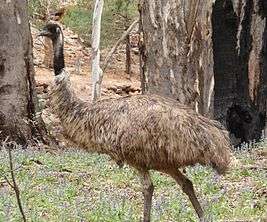Emu oil

Emu oil is an oil derived from adipose tissue harvested from certain subspecies of the emu, Dromaius novaehollandiae, a flightless bird indigenous to Australia.[1][2]
Unadulterated emu oil can vary widely in color and viscosity anywhere from an off-white creamy texture to a thin yellow liquid, depending on the diet of the emu and the refining method(s) used.[3] Industrially refined "emu grade" emu oil is composed of a minimum of 70% unsaturated fatty acids. The largest component is oleic acid, a monounsaturated omega-9 fatty acid. Emu oil also contains roughly 20% linoleic acid (an omega-6 fatty acid) and 1-2% linolenic acid (an omega-3 fatty acid).[4] Fully refined emu oil has a bland flavor. [4]
Emu oil has previously been wrongly promoted as a dietary supplement with the claim it can treat a variety of human ailments, including cancer and arthritis.[5]
Commercial emu oil supplements are not standardized and vary widely in their potency.[6] The U.S. Food and Drug Administration highlighted emu oil in a 2009 article on "How to Spot Health Fraud," pointing out that many "pure emu oil" products are unapproved drugs.[5]
Research
As of 2015 there have been two small human studies.[7] One looked at emu oil as a skin moisturizer and the other as an insect repellent.[7] The papers published from these studies note emu oil's future potential, citing "its possible antidiabetic activity" as "an attractive pharmacologic agent to further explore for its therapeutic activity to treat various ailments."[8]
See also
References
- ↑ American Emu Association FAQ
- ↑ Devantier, Alecia T; Carol, Turkington (2006). Extraordinary Jobs in Agriculture and Nature. Infobase Publishing. ISBN 978-0-8160-5854-9.
- ↑ American Emu Association - Definition of emu oil grades
- 1 2 "Emu Oil Trade Rule 103" (PDF).
- 1 2 Kurtzweil, Paula (April 30, 2009). "How to Spot Health Fraud". U.S. Food and Drug Administration. Retrieved June 29, 2009.
- ↑ Whitehouse MW, Turner AG, Davis CK, Roberts MS (1998). "Emu oil(s): A source of non-toxic transdermal anti-inflammatory agents in aboriginal medicine". Inflammopharmacology. 6 (1): 1–8. PMID 17638122. doi:10.1007/s10787-998-0001-9.
- 1 2 Jeengar et. al (2015). "Review on emu products for use as complementary and alternative medicine". Nutrition. 31: 21–27. doi:10.1016/j.nut.2014.04.004.
- ↑ Jeengar et. al (2015). "Review on emu products for use as complementary and alternative medicine". Nutrition. 31: 21–27. doi:10.1016/j.nut.2014.04.004.